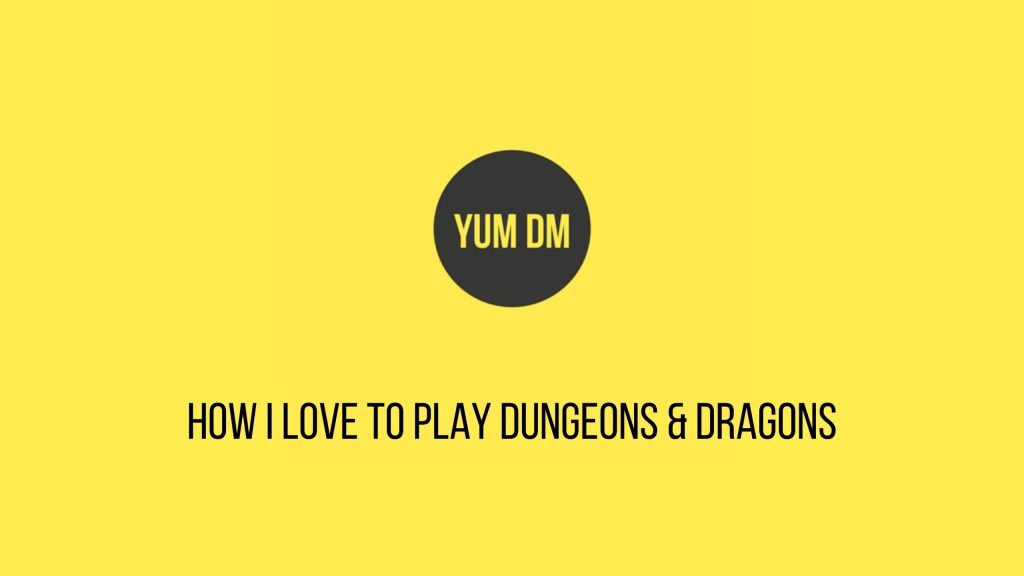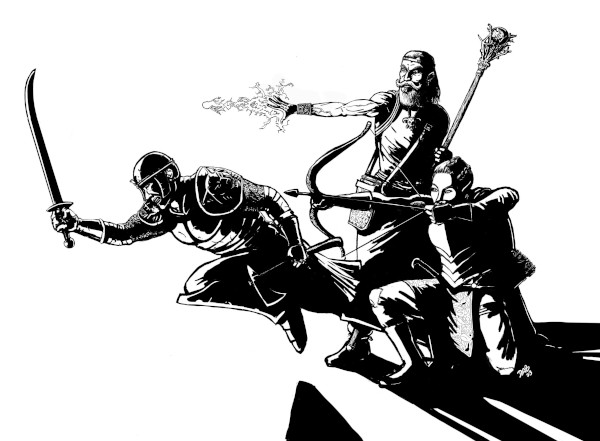
There are many ways to play Dungeons & Dragons (D&D), and if you ask 10 people they will most likely give you 10 different answers on how they like to play.
This post is all about how I like to play.
I wanted to write this as a gateway to learning more about how I play D&D.
And, from there, you can learn and understand the parts that make up what I love about playing D&D this way. So, you too, may incorporate them into your campaign.
Generally, I prefer “old school” ways of playing, but, again, this means different things to different people, so let me write a list of what I love to see in a D&D campaign.
-
-
- Sandbox
- An active & living world
- Tight time-tracking
- No balancing encounters
- Random encounters
- Reaction rolls
- Resource management
- Focus on exploration
- Multiple characters per player
-
In future posts, I will go over these separately and in depth, but I did want to explain and expand on them a little here, so we are all on the same page.
Make sure you bookmark this post as I will link to the new posts below as they are published.
Sandbox
I have written about sandbox campaigns previously. Defining it and expanding on how you can start one in a few hours, and then continue to expanding your campaign world as you play.
I will copy the definition I use in that post below:
A sandbox Dungeons & Dragons campaign is a style of gameplay where the Gamemaster (GM) provides players with a detailed and dynamic game world, but rather than following a strict linear plot, the players are encouraged to make choices and pursue their own goals within this open-ended environment.
As mentioned in that previous post, there are many components that make up a sandbox (some of which are in my initial list above) that help create and define it. I recommend checking out that post as it goes into some detail on what a sandbox is and what goes into making one.
Continue Reading: Sandbox D&D Campaigns – Dealing With The Misconceptions
An Active & Living World
In regular adventures, PCs see only a small part of the campaign world as they move from point A to point B, and their interactions with it are similarly limited. The antagonists of the adventure react against what the PCs do (or perhaps just ignore them altogether) as they try to stop the Big Bad from doing that Big Bad Thing.
In an active and living campaign world, where the PCs can go anywhere and do anything, it’s the world that reacts to them, rather than one or two antagonists.
And by ‘world’ I, of course, mean everything within it. If the PCs explore an ancient tomb, that tomb is forever explored, and those who swore an oath to protect it will be looking for a way to exact revenge upon the PCs sooner rather than later.
In other words, whatever the PCs do has some impact on the world around them, be it large or small, good or bad.
Continue Reading: Building an Active and Living D&D Campaign World
Tight Time-Tracking
I am not going to lie, this can take some effort on the behalf of the GM to keep track of, but in my mind, the advantages it has far outweigh the effort involved.
At the very least, this includes knowing the date and year of the world you are exploring. But it also means knowing what the PCs (and sometimes important NPCs) are doing.
This is especially true if the player has several characters they play (see Multiple Characters Per Player, below).
In essence, it means keeping track of each character so the players and yourself know who can adventure and who are busy with other activities (like researching a new spell or recuperating after a dangerous adventure).
Continue Reading: Coming soon.
No Balancing Encounters
The quest for perfect balance in D&D is a fruitless task.
And creating encounters to meet the PCs’ abilities instantly means that the campaign world revolves around them. Which, in an open and active world, is not the case at all.
If the PCs wander into the wrong area (despite the clues given by the GM) then that’s their mess to get out of. And running away is always an option.
In this way, the world becomes more real to the players and keeps them thinking, and on edge.
Continue Reading: Coming soon.

Random Encounters
I have written a lot about random encounters on this site (I even thought they were important enough to dedicate a whole issue of d12 Monthly to), but I will go over it again briefly here.
Random encounters are a great way to make your world feel alive and lived in.
This is especially true if you create your own encounter tables, tailoring them to certain areas within your campaign world.
And random encounters are not always about combat. Entries on the table can include things like random events, NPCs (that the PCs know or not), weather, and anything you can think of.
Continue Reading: Why Random Encounter Table Are So Good and How to Build Your Own Tables
Reaction Rolls
I have spoken about reaction rolls on this site previously, but it is worth going over again.
Reaction rolls alleviate the GM having to make up how monsters or NPCs react to the PCs. It also has the added benefit of allowing the GM to share in the surprise of the opposition’s reactions – will they be friendly, unfriendly, aggressive, and just meh?
It can also be used in many other ways as well, which we will explore in more depth in a future post.
Continue Reading: Coming soon.
Resource Management
This is an important one, but also one of the most derisive ones.
But it is SUPER IMPORTANT.
As an example of how important it is, and what you can achieve from it, I totally recommend reading Don’t Split the Party’s blog post on resource management.
And it doesn’t need to be arduous.
I tend to use a slot-based system you can find in Issue 7 of d12 Monthly to manage most resources. For spell components, I use a simple dice type system, which can be found in Issue 4 of d12 Monthly (this issue also has rules for augmenting spells using rare components).
Continue Reading: Coming soon.
Focus on Exploration
By this I don’t just mean trudging through the wilderness, but that is definitely part of it. I also mean exploring any and everything about the campaign world. Whether that be the town the PCs are in, or a guild or faction, or in the wilderness, moving from one spot to another.
This is an important part of D&D (and one the modern game has forgotten) as it allows the PCs to interact with the world in one way or another.
And while some believe this is the main reason a sandbox cannot work – as it would take too long to create all this – it is easily disputable (something I do in my post on creating a sandbox).
To put simply, you just create the parts of the world as you need them.
Continue Reading: Coming soon.
Multiple Characters Per Player
This is one that is probably the least popular and one that may not work for every group, but one I very much like.
Basically, each player makes up 2-3 characters and plays whichever one is available and seems appropriate at the time.
This ties strongly in with Tight Time-Tracking above, as one or more of the player’s characters may not be available when the party wants to adventure.
For example, a mage character may be researching a new spell and is not available. The fighter may be off on a side-quest and not even in the city, and the cleric could be part of a week-long religious festival which they cannot ignore.
Availability is just one part of it, though.
There could be strategic reasons to take one character over another.
If the players decide they want the party to check out a local crypt, then taking the cleric over the fighter may be a great idea!
Having multiple characters gives players more options.
Continue Reading: Coming soon.
Over to You
Which of these do you enjoy using in your D&D campaigns? Let me know in the comments below.
While You’re Here…
Since 2021 I have been publishing d12 Monthly, a monthly zine, which has a ton of articles for any edition of Dungeons and Dragons.
Printed copies are available in my store. The PDF is available on DriveThruRPG and you can get both, plus support my work, via my Patreon.
I will also be releasing some more products in the near future.
Feel free to reach out to me on Twitter or my contact page any time.

I too like to use most of these. I like a lighter, faster, game, but don’t want to be too OSR (the PCs should be capable adventurers). It’s hard to find a game that suits that style so I hacked my own. Dungeon Dwellers by Reaper looks promising. My problem with Shadowdark, OSE, and other OSR games is the PCs tend to be samey and squishy. I like having character options, but don’t want all the 5e HP bloat and complexity and all the PF2e complexity and power curve.
Hey Ryan. Yeah, I know how you feel. I am working on my own mashup, which will have a B/X base with stuff from 2nd ed and 3e – I particularly like the character options from 3e so trying to add some of that in, without over-complicating it. Dungeon Dwellers does look pretty cool! Did you end up backing it?
I think we are actually in agreement here. All of those points are what I also like about the game, and what in fact always drew me to this game.
Lately I have come to the realization that what I really like about a game is actually, according to the threefold model, Simulationism. I am someone who likes the idea of simulating a world that people can interact with.
Thanks for the reply. 🙂
I just love worlds I can explore and make sense of. And I try to impart that in the games I run.